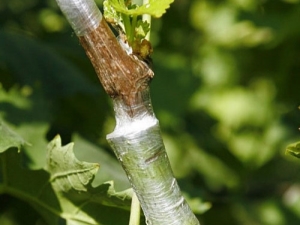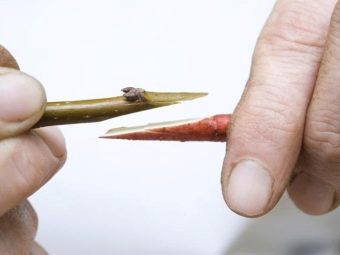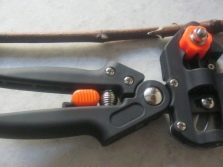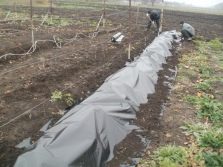How to inoculate grapes?

People who do not like grapes, a little. He has a lot of varieties, and for everyone there is a connoisseur.Unfortunately, the varieties with the most delicious and juicy fruits are not winter-hardy and unstable to the effects of pests, therefore they are rapidly dying. But this can be prevented by grafting a whimsical variety to another, less fastidious one. So you can save and multiply the crop.
What is needed?
There are several answers to the question of why grapes are grafted, and each one is completely exhaustive:
- To replace the varieties, multiply more valuable in quality, and get a harvest rather than uprooting a bush and waiting for its fruit bearing.
- To restore the growth of the bush with a damaged aboveground part.
- To grow grapes on different types of stock. Then he successfully resists phylloxera, winter-hardy, and also less responsive to soil salinity and proximity of groundwater.
- To quickly reproduce valuable and rare grape varieties, grafted on an adult shrub.
- To form family bushes, which is especially important for small vineyards.
- In addition, the vaccine makes it possible to grow not one, but two or three grape varieties on a single shrub. Besides the fact that it is tasty, it also looks very nice in the overall composition of the summer cottage, at the same time saving space. This is especially valuable for gardens with a small area.
- If for some reason the graft does not like, you can change it to another. It is not necessary to plant a new bush for this, it is enough to vaccinate “in the cleft” of the desired variety.
If you have previously happened to plant apples or pear trees, it means that everything will go smoothly with grafting, - there are some nuances in the procedure, but in general the technology is the same. For the vaccination to be successful, you need to prepare two things: a graft and a stock, and do it according to the rules.
Timing
The “green to black” method is very convenient in that it can be used in each of the summer months. It is made with the help of a woody stalk, in which a green shoot is placed. The cuttings are prepared in September, in the summer they update the cut, which should be located at a short distance from the growth point. The cut must be sharpened, giving it a wedge-shaped shape. Then the shoot is placed in a basin or bucket of clean water and must remain there until the buds swell. If the buds are not swollen, then the cutting is not suitable for vaccination. To stimulate the growth of cuttings, they are placed for a third of an hour in a special composition.
After swelling of the kidneys go directly to the vaccination procedure. It is produced either in the early morning, or after six in the evening, if the day is sunny. If not, any time will do.
The stock (the so-called vine, on which the cuttings are planted) should be properly prepared: it is necessary to cut a part of the shoot from it and make an incision in the middle. Its depth should not exceed 3 cm.
June-July is the right time for grafting a green stalk to a similar shoot. This is the same technique as the “butt”, with the difference that the cutting does not require the revival of water or growth stimulants. Cuttings are cut from the bush of the variety that they want to plant, just before being placed in the incision. Next, the cut is sharpened into a wedge-shaped form and, finally, placed into an incision on the stock.
Autumn inoculation is produced in a split stem of an elderly bush, which has become worse to bear fruit. In order for the splicing to go well, it is necessary to properly split the stem and prepare cuttings. First, they are soaked in one of the growth-promoting compounds, where they lie for a couple of days. After this, it should be obvious that the cutting is alive: swollen buds will be visible on it, leaves will be covered, antennae will appear.
In the first days of October (if the temperature is kept at + 15 degrees), it is necessary to carefully cut off a part of the stem above the ground, then clean the cut-off area with a sharp knife that has been previously disinfected. After this, the cut is wiped with a damp cloth.
Next, take a screwdriver with a straight nozzle, insert it in the middle of the trunk and drive it with a hammer 3 cm deep.The tip of the cutting, pointed in a conical shape with a cut of not more than 3 cm, is inserted into the cut. If the perfect fit did not work and left a gap, they are sealed with wet napkins or pieces of vine. Then you need to tie a place of vaccination firmly (but not overtighten!) With a piece of cotton rag or twine and cover it with one of the means to protect against drying out (this can be wet clay, garden pitch or other).
If the stem is much wider than the cutting, then two or three cuttings can be planted on one stem.
Winter vaccination is suitable for young bushes no older than two years. It is held from January to March inclusive, but you need to prepare for it in the fall. After the foliage has been dropped from the bush, it is dug out, cut to a height of ten centimeters, and the entire above-ground part is disinfected with a saturated solution of potassium permanganate. Then the bush in this form is placed in a container with a mixture of sawdust and sand and stored in a dry cool place with an air temperature of about 0. 24 hours before the grafting, the stock is taken out, subjected to thorough cleaning, all rotten roots are cut and the healthy ones are shortened up to a length of 15 cm.
Then for several hours it should be stored in a warm room with a temperature of 18-20 degrees. After that, the stock is placed a basin with water, its temperature should be about 15-16 degrees. In this form, the stock is stored 24 hours. At the end of the day, it is taken out, wetted with dry clean rags, and the graft of the desired variety is grafted onto it in any desired way from those described above.
Grafted rootstock and graft should be placed in a container of a suitable size, covered with cellophane and left in a warm place with a temperature of about +25, the central heating battery is well suited - next to it or on it conditions are optimal. In this form, the design should stand from two to three weeks, after which it is again rearranged into sand and sawdust and placed in a dark and cool place.
In the spring time, as soon as the temperature is established and will not fall below 15 degrees, you need to pull the grafted bushes out of sand and sawdust, carefully cut off all that died, give the bush to "settle down" on the street for two or three days, and then finally plant in open ground. Such a winter vaccination is differently called the desktop.
Care
After any vaccination, regardless of whether it is summer, spring or autumn, the stock needs watering and hilling. Soil near pristvolnogo circle should be properly plowed. This will help the soil get enough oxygen.
Grafting a stalk in the split in a shtambe, you do not need to pour the ground where the graft and the rootstock join.
Two weeks after vaccination young shoots should appear on it. If this does not happen, you need to cut the inoculation and part of the stock and plant the same cutting again.
Once every ten days it is necessary to check how the graft and the stock grow together. If the cutting takes root not in the stock, they need to be carefully cut, otherwise they will harden in the ground. Then you can’t talk about vaccination, it's just planting a cutting.
In addition to the above, you should perform all the usual measures for the care of a plant: loosening the soil, getting rid of weeds, watering.
Ways
A sure sign that it's time to vaccinate is when you see swollen kidneys. Most often it is April. The temperature should set, sudden drops are unacceptable, cold nights - too. Must be stable heat.
What are the ways of vaccination?
Budding. When grafting this method, the shield is cut from the shoot with indentations of 2 cm up and down. After that, the shield is applied to the stock with exactly the same pre-made cut. Place the joint to wrap adhesive tape or a piece of twine.
Underground butt
That sapling to be used as a stock is grown independently. In the spring, it is cut about 4-5 cm deeper than the ground level.On the remaining chips, a transverse incision is made, into which a wedge-shaped sharpened pin of wood is placed. Its length is about 3 cm, in diameter - 5 mm. A stem is used on this rod, used as a graft. Wet cotton cloth is tightly wrapped around the junction of the pin and the graft, on top of the structure crowns tightly tied cellophane.
The fabric should not be allowed to dry, it must be constantly wetted, without disturbing the tightness of the package. When buds are bloomed on the graft, the packet is cut, and after the shoots appear, they are completely removed.
The cuttings are best vaccinated when the eyes on it have just started to germinate. If they outgrow, the cutting is unlikely to take root.
"Oblique copulation"
It is possible to inoculate in the way “oblique copulation”, it is possible - “to split”. In the first case, you need to leave a small "tongue" on the trunk or stock. Whatever method of the two you choose, you need to remember that the place of the joint of the scion and rootstock must be treated with a special compound that will accelerate their merging. In addition, it is necessary to fill this joint with paraffin to prevent diseases of the fragile seedling. Or, if for some reason you do not want or can not wax the junction of the cutting and the bush, it is wrapped with a clean cloth moistened both in water and in the composition that accelerates growth, and on top also with a layer of cellophane.
Thus, the grafted shoots need to be stored in boxes, on each of the layers put the material that holds moisture, and on top of it - the film. The temperature should not fluctuate more than 2 degrees and should always be near the mark showing +20 degrees. If the water-holding material is not at hand, do not worry. It is easy to replace wet sawdust.
"In the split"
Grafting in a “split” mode can occur as “black to black” or “green to green”. Both of these options are popular with gardeners. For the first method, choose the shoots of the past or the year before that, which are specifically left for this purpose. They are grafted into a shaped, perennial vineyard. And for the second method, both the graft and the stock should be fresh, equal in age. Accordingly, for a “green” vaccination, the shoot is cut directly in front of it, immediately after the cut it is placed in water, and then in a shell.
If the vaccination is successful, then excess roots, eyes and shoots will grow on the stock. It is necessary to get rid of them so that the bush is formed strong. Otherwise, top dressing will not go where it is needed (to the junction point). Winding rags need to keep at the junction until the end of August.
It is convenient to vaccinate with a Korean graft pruner - it comes with three sharp knives, which makes it easier to cut the cuttings.
The grafting method on shtamb differs from the other in the number of rootstocks: there must be at least two of them, and on each at least three eyes. Vaccination is done until the end of spring.
Also, grapes can be grafted onto mulberries (by drilling), but experienced gardeners note that this is a laborious way, and it is not always effective. The technology for this vaccination is as follows:
- drill a hole in the mulberry;
- clean the lower part of the stock from the bark and insert it into the drilled hole;
- if the accretion is successful, then the escape must be detached from the common bush and planted in a separate hole in the open field.
Harvesting and preparation
In order for the graft and the rootstock to grow together, it is necessary to sow - in other words, the movement of juices.
Preparation of cuttings for the future vaccination procedure takes place in the fall. At the same time, each vine bush is pruned for the cold season. The cut stalk must have a certain number of buds - at least four. Keep them in a damp cloth moistened with water, wrapping cellophane on top.
The bush itself, in which it is planned to plant cuttings, is carefully pruned, leaving one vine, and covered for the winter period. Before you vaccinate, you need to open the bush.
If the grafting is done using the “green” method, then there is no need to prepare the shoot, it is cut off just before grafting.
How to instill?
In order for all your stocks to take root, you need to follow these guidelines.
- Everything has its time. If you decide to make a spring vaccination, its “season” is the beginning of the juice movement, the summer one - from the beginning of June to mid-July, the autumn one - to the first numbers of August before the vine ripens.
- The winding of the junction should be done in such a way that not a drop is leaking from under it. It should be as tight as possible.
- The temperature regime should be as recommended at all stages of the inoculation procedure.
- The cambial layers should be completely displaced, otherwise there is a high probability of burns on the cuttings.
- Planting a graft, do not forget to fill the ground.
- If additional growth points appear on the seedling, in addition to the graft, they should be discarded. If you are engaged in growing grapes in the southern region, this rule can not be observed, because the soil there is so fertile, and the sun - generously, that grows all.
Errors
If you are planting grapes for the first time, then by no means do amateur activities. Experienced winegrowers have already thought of everything for you, so the most important thing is to choose the method of vaccination and follow all recommendations with one hundred percent accuracy.
It is best to talk with people for whom this process is not new, and see firsthand how and in what sequence you need to act.
To make your vaccination procedure successful:
- choose the varieties that are optimal for your climatic zone - the sun-loving "southern" variety will be difficult to grow in Siberia;
- if you have harsh winters in your region, consider winter-hardy varieties;
- try to ensure that the graft and stock coincide in strength of growth;
- graft needs to be prepared in the fall, to store in a subfield or the refrigerator;
- when grafting it is necessary to use a special, very sharp knife;
- sharpen the cutting carefully, it must be strictly wedge-shaped;
- the cutting is cut in the direction “from itself”, otherwise the cut will have a concave shape;
- even if the graft and the stock have successfully grown together, you need to control the place of the joint and protect it;
- the length of the slice on the handle should be exactly the same size as the depth of the incision of the graft.
For information on how to make a "green graft" of grapes, see the next video.




















































